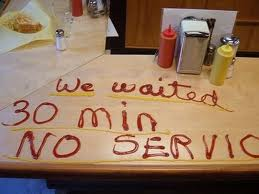FBOs and charter airlines are in a strong position to capitalise on the belt-tightening consequences of recent economic conditions. That’s providing they are able to articulate their value in a meaningful way.
 Value, to paraphrase, is in the eye of the beholder. Understanding what that means in reality and then being organised to do something about it puts companies on track for that competitive edge and long-term growth and stability they need.
Value, to paraphrase, is in the eye of the beholder. Understanding what that means in reality and then being organised to do something about it puts companies on track for that competitive edge and long-term growth and stability they need.
Focusing on customers is nothing new. In designing and implement customer strategies, there’s no shortage of advice on why that’s a good thing. But the piece that’s often missing is how to use it in a way that creates real business benefits.
Here are some tips that go some way to plugging the gaps.
Customer journey mapping
“We need a customer journey map for that” is a common call that’s heard in workshops aiming to lift the levels of customer service. Unfortunately, what gets put on the table is just as often a linear process map, an operations manual or a sales checklist. They give a starting point but little in the way of direction.
A good journey map is itself a means to an end. It will give everyone a common version of what it’s really like to be a customer. It points to where effort and resource needs to be focused and it provides others across the business with critical information about how best to achieve their own individual goals. Most importantly though, it forms the platform of knowledge on which future decision-making is based.
It is therefore the output and what is done with it that counts. There’s no golden rule about what the map should look like, it must simply work for your organisation in a credible way that tells the story of what the opportunities are and why. The tighter the scope the better. For example, a forensic look at the tablet-based booking process for a high-value, regular customer or the welcome experience for a new-to-business-aviation client will yield more actionable and effective insight than a one-size-fits-all approach.
Understanding the customer’s perception of what happens every step of the way, set against what should happen and what drives value for the business, will flush out detailed commercial considerations. What does good look like? How do we compare? What does this customer (or customer type) really value and how well do we do it? What are the unintended consequences? If we’re over-delivering in an area that the customer doesn’t see as a priority, can we save costs there? And so on.
With robust leadership and governance, the journey map makes sure the right activity is prioritised, the right people are held to account and the right measurement programme is in place to perpetuate improvements.

Wanted: to know what our customers tell each other that they don’t tell us
Today’s customers will sit down to dinner tonight with family or colleagues and share a story or two about their flight(s). It would be great to be a fly on the wall but with the journey mapping having created pre-meditated and dependable experiences, when the chairman asks if we know what they are saying not only can we answer “yes”, but we can also articulate how that is adding value to the business.
Commercial benefits
Business aviation is no different from many other markets in that standing out from the crowd is increasingly as difficult as it is necessary. But for those who place a spotlight on getting things right, the commercial benefits are as much non-financial as they are financial.
Collecting first-hand evidence of what works for customers and their own internal stakeholders back at their office shapes strategic as well as tactical decisions. It means the weaknesses and inflexibility of commercial aviation alternatives can be articulated to best effect. It helps recognise how much competitors might include video conferencing. It flushes out how customers want to pay and reveals insights for lobbying airport owners and regulatory policy makers. Such knowledge also ensures all activity across the company is working to the same priorities and that marketing investment isn’t wasted when something other than the brand promise is delivered.
 While business aviation has to navigate around a plethora of political, regulatory and infrastructure issues, it also wrestles with the issue of perception. For many clients, the economic climate has put cost management at the top of their agenda yet brands and communications targeting corporate accounts still ooze indulgence rather than productivity advantages. That’s fine if the chosen target market is the luxury seeker, but a sceptical programme director overseeing an urgent M&A project will only let the team fly privately if the broader economic benefits for the business case are clear. Therefore, getting to understand the customer and their own organisation is essential for business aviation companies who can then provide the right information that makes that business case uncontested.
While business aviation has to navigate around a plethora of political, regulatory and infrastructure issues, it also wrestles with the issue of perception. For many clients, the economic climate has put cost management at the top of their agenda yet brands and communications targeting corporate accounts still ooze indulgence rather than productivity advantages. That’s fine if the chosen target market is the luxury seeker, but a sceptical programme director overseeing an urgent M&A project will only let the team fly privately if the broader economic benefits for the business case are clear. Therefore, getting to understand the customer and their own organisation is essential for business aviation companies who can then provide the right information that makes that business case uncontested.
Diverting finite resources for an even greater customer focus might take some persuading for metric-driven stakeholders. The translation therefore of customer measurements such as the net promoter score (NPS) and of customers’ emotionally-driven behaviour into real money makes the case forcefully.
Medallia’s research into NPS – the popular measurement tool which asks customers how likely they are to recommend your business – shows that on average, those who are willing to be an advocate are worth 30% more than those who are not. The Temkin Group also showed that promoters are five times more likely to repurchase than detractors.
A joint piece of research between Forrester and Watermark Consulting tracked the correlation between organisations that had a customer experience focus and their stock-market performance. In that five-year period, the S&P 500 market index dropped by -1.5%; companies on the front foot with customer engagement increased by +22% while those dragging their feet fell by 46%.
Traits of successful FBOs and charter airlines
Somewhat unhelpfully, successful FBOs and charter airlines come in all shapes and sizes. Some brands make a feature of being loud and brash while others go about their business quietly, but very effectively, keeping well under the radar.
The one thing they all have in common is good people. Flat fee options, in-flight connectivity that replicates being in the office and a highly responsive service will count for nothing without the right people. They understand what the company is all about, they know what it needs to do day-in and day-out to succeed and they are energised to accomplish at least that on a daily basis.
Steve Jones, Managing Director, Marshall Aerospace said of their success: “In the last year it’s all been about accumulating a strong team and so far it has been more about building expertise than building things”
Thomas Flohr, Chairman of VistaJet which regularly has 20-25% revenue growth, bypasses the fractional model – “We tore up all the old conventions and designed a revolutionary business model focused entirely around our clients. What they wanted. What they needed. We’ve never looked back.”
And earlier this year, Rizon Jet said that its awards were due to a “Dedication to fantastic customer service….it’s not just the facility, but the people that make the difference”.

Organic business growth
A further illustration of how customer service can trump price came in the AIN FBO survey – Americas 2013. Customers were asked to cite the most important factors when choosing an FBO: 85% said good customer service, the top answer. And the top reason for avoiding an FBO? 71% said poor customer service.
Another common factor of successful businesses is having the right customer feedback programme. In X-Jet’s own words, “Truly we do live for that connection with the customers and we’re constantly seeking feedback on how we can do things better”
Lessons from other industries
Markets outside business aviation are also finding that the bar of expectation is rising all the time. As law firms are discovering to their cost, the world around them has changed and in their clients own lives they are interacting more and more effortlessly with a host of other organisations through an array of devices and channels.
Apple is a regular contender for exemplary customer service. That’s not surprising with the focus it has on recruiting the right people for its brand, the focus it has on customer empathy rather than selling and on evoking the right emotions.
In March this year, Marriott headed the Temkin Group rankings once again for a hotel brand’s customer experience. Like Amazon and NetFlix, they create relevant personalisation and make it easy to do business with. They focus on the things their customer value, whether it’s helping the procurement team choose Marriott over a cheaper alternative down the street or tracking down lost luggage.
Many of these results stem from having (read: “allowing”) its people talk directly with customers. These organisations also have strong leadership for a clear customer strategy that is shared and understood by every employee.
Conclusion
Companies in the business aviation market are not on their own in needing to articulate their real value to existing and new customers. But for those who get it right, delivering what is valued most and what is seen as value for money, customers will reflect that they made the right decision, their organisation will benefit and they’ll tell everyone. And that’s invaluable.












